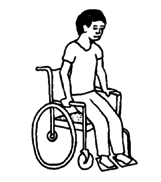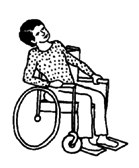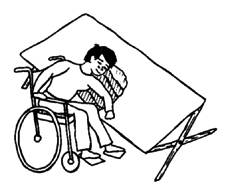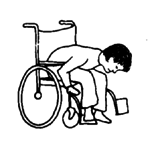CHAPTER 24
Pressure Sores
WHAT ARE THEY?

Pressure sores, or 'bed ores', are sores that form over bony parts of the body when a person lies or sits on that part of the body for too long without moving. Where the skin is pressed against the bed or chair, the blood vessels are squeezed shut so that he blood cannot bring air to the skin and flesh. If too much time passes without moving or rolling over, the skin and flesh in that spot can be injured or die. First a red or dark patch appears. And if the pressure continues, an open sore can form. The sore may start on the skin and work in. Or it may start in deep near the bone and gradually work its way to the surface.
Who is likely to get pressure sores?
When a normal healthy person lies or sits in one position for a long time, it begins to feel uncomfortable, or to hurt. So she moves or rolls over, and pressure sores are avoided. People most likely to get pressure sores are:
1. persons who are so ill, weak, or disabled that they cannot roll over by themselves. This includes persons severely disabled from polio, brain damage, advanced muscular dystrophy, or a bad injury.
2. persons who have no feeling in parts of their body, who do not feel the warnings of pain or discomfort when their body is being damaged. This includes persons with spinal cord injury, spina bifida, and leprosy.
| WARNING: Because persons with spinal cord injury are at first unable to turn over, and also have lost the ability to feel in parts of their bodies, they are at very high risk for pressure sores. |
3. persons who have a plaster cast on an arm or leg (to correct a contracture or to heal a broken bone), when the plaster presses over a bony spot. At first the pressure will hurt and the child may cry or complain. But in time the spot will grow numb and the child will stop complaining-although a sore may be forming.
The risk is greater when using casts on children who have no feeling in their feet. On these children, even a corrective shoe or brace can easily cause a pressure sore - unless great care is taken.

Casts to straighten contractures and clubbed feet must be very well padded over bony places to prevent pressure sores. |
Where are pressure sores most likely to form?
They can form over any bony area. The places where they form most often are shown in the pictures.
The points of highest risk, all on the hips, are marked in CAPITAL LETTERS.
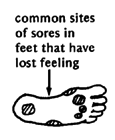

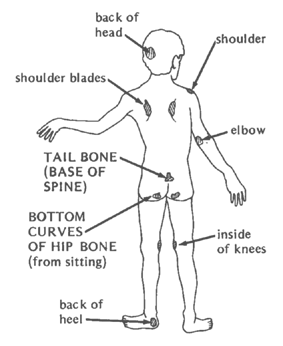
How dangerous are they?
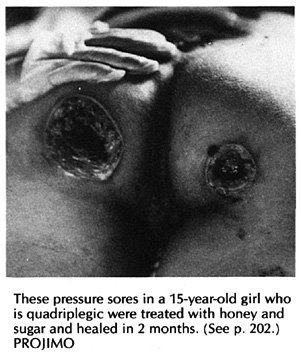

Pressure sores, if not very carefully cared for, can become large and deep. Because they contain dead skin and flesh, they easily become infected. If a sore reaches the bone, which it often does, the bone can also become infected. Bone infections are often very hard (and costly) to cure, may last for years, and may keep coming back, even after the original pressure sore has healed. (See "Bone Infections," Chapter 19.) Bone infections can lead to severe disabling deformities.
Infections in deep pressure sores often get into the blood and affect the whole body, causing fever and general illness. This can lead to death. In fact, pressure sores are one of the main causes of death in persons with spinal cord injury.
See Page 202.
In persons with high spinal cord injuries (quadriplegia) the irritation from pressure sores can also bring about sudden severe headaches and high blood pressure (dysreflexia, see Page 187), which can also cause death.
How common are pressure sores?
In persons who have lost feeling in parts of their body, pressure sores are very common. Most spinal cord injured persons in rich countries, and nearly all in poor countries, develop pressure sores. Often the sores start in hospitals shortly after the back injury, due to inadequate nursing care. Therefore, it is important that families of spinal cord injured persons, and the persons themselves, learn as early as possible about the prevention and early treatment of pressure sores, and take all the needed steps.
PREVENTION OF PRESSURE SORES
| It is important that both the child and family learn about the risk of pressure sores and how to prevent them. |
| Avoid staying in the same position for very long. When lying down, turn from side to side or front to back at least every 2 hours (or up to 4 hours if padding and cushioning are excellent). When sitting, lift body up and change position every 10 or 15 minutes. | |
| Use thick, soft padding, pillows, or other forms of cushion arranged so as to protect bony areas of the body. (For cushion designs, see Page 199 and 200.) | |
| Use soft, clean, dry bed sheets. Try to avoid wrinkles. Change bedding or clothing every day and each time the bedding gets wet or dirtied. A person who stays wet gets pressure sores- especially if it is from urine. | |
| Bathe the child daily. Dry the skin well by patting, not rubbing. It is probably best not to use body creams or oils, or talc, except on the hands and feet to prevent cracking, as these soften the skin and make it weaker. Never use heat-producing oils, lotions, or alcohol. | |
| Examine the whole body carefully every day, checking especially those areas where sores are most likely to occur. If any redness or darkness is present, take added care to prevent all pressure over this area until the skin returns to normal. | |
| Good nutrition is important for preventing pressure sores. Be sure the child gets enough to eat (but do not let her get fat). Give her plenty of fruits, vegetables, and foods with protein (beans, lentils, eggs, meat, fish, and milk products). It the child looks pale, check for signs of anemia (see Page 320) and be sure she gets iron-rich foods (meat, eggs, and dark green leafy vegetables) or takes iron pills (ferrous sulphate) and vitamin C (oranges, lemons, tomatoes, etc.) | |
| As much as is possible, the child should learn to examine her own body for pressure sores every day and take responsibility for all the necessary preventive measures herself. |
Other precautions
| To avoid pressure sores or other injuries on feet that do not feel, use well-fitted, well-padded sandals or shoes. These and other precautions are discussed under "Spina Bifida" (Page 173) and "Leprosy" (Page 224). |

| To avoid pressure sores when straightening limbs with casts, put extra padding over bony spots before casting and do not press on these spots as the cast hardens. Listen to the child when he says it hurts, and check where it hurts. |
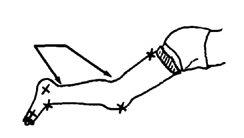
If it hurts in these spots, it is probably the tight cord (tendon). A little pain is normal with stretching, but if it hurts a lot, examine it.
If it hurts in one of the spots marked with an X, it may be a pressure sore. Remove the cast and see.
Changing positions
When a child has recently had a spinal cord injury, he must be turned regularly, taking great care not to bend his back.

As the child gets stronger, hang loops and provide other aids, if needed, so she can learn to turn herself.


At first it is important that the person turn, or be turned, at least every 2 hours, day and night. Later, if there are no signs of pressure sores, the time between turns can gradually be lengthened to 4 hours. To avoid sleeping through the night without turning, an alarm clock can be a big help.
When the child begins to sit or use a wheelchair, there is a new serious danger of pressure sores. The child must get into the habit of taking the pressure off his butt every few minutes.
| Juan has strong arms. He can lift up his whole
body and hold it up for a minute or two. This lets the blood
circulate in the butt.
|
| José s arms are weak. He takes the pressure off
his butt by leaning his whole body over the armrest, first on
one side, and then on the other.
|
| Carlota has a wheelchair with a low back, so
she can lean back and lift her hips off the seat.
|
| If the chair has no armrests, or they can be
removed, the child can lie sideways over a pillow on a high bed.
He can rest for 15 to 30 minutes like this.
|
| If he has very little arm and body control, he
can put his feet on the floor (with help if needed) and lean
forward with his chest on his knees. This takes the pressure off
his butt.
|
| Or have someone tip his chair backward for one
minute or more. For a longer 'nap' that rests the butt, someone
can tip his chair backward onto a cot.
|
| To prevent pressure sores when sitting, take the weight off your butt for one whole minute at least once every 15 minutes! |
Padding and cushions for lying
To prevent pressure sores, it is essential that the person who has lost feeling lie and sit on a soft surface that reduces pressure on bony areas.
· It is best to lie on a flat surface with a thick, spongy mattress.
A thick foam rubber mattress often works well. However, some foam is so spongy that it sinks completely down under weight. Then the bony area is not protected from the hard board. A firm sponge with very small air bubbles(microcell rubber) works well, but is expensive.
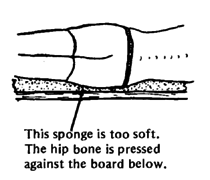

A 'waterbed' (bag-like mattress filled with water) or air mattress also works well.
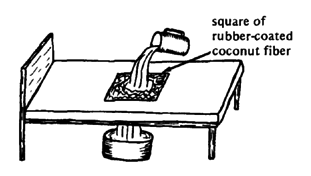
In some countries, an excellent mattress material is made of rubber-coated coconut fiber. Urine can be washed out by pouring water through it. Because this material is costly, a rehabilitation program in Bangladesh cuts a square out of a cheap mattress and fits in a square of the coconut fiber sponge.
· Careful placement of pillows, pads, or soft, folded blankets can also help prevent pressure sores. These are especially important in the first weeks or months after a spinal cord injury when the person must lie flat and be moved as little as possible. Pillows should be placed to avoid pressure on bony places, and to keep the person in a position that is healthy and that helps prevent contractures.
BACK-LYING
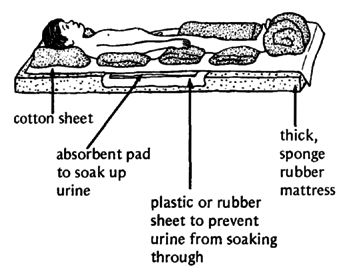
SIDE-LYING

For self-placement of pillows, see Page
184.
BELLY-LYING

urine collection tube (See Page 204.)
Chair and wheelchair cushions
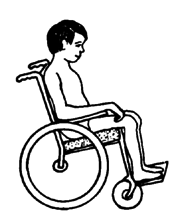
For the child who has lost feeling in his butt, the type of seat cushion he uses is very important-especially if his paralysis makes it difficult to lift up or change positions.
All spinal cord injured persons should use a good cushion. Sitting directly on a canvas or a poorly padded wood seat causes pressure sores.
Special cushions are made with 'soft spots' of an almost-liquid 'silicone gel' in the areas of greatest pressure. However, these cushions are very expensive. Also, the gel may get too soft and liquid in hot weather.
Good cushions can be made of 'microcell' rubber, which is fairly firm. It works best if it is cut and shaped to reduce pressure on bony areas:

A good, low-cost way to make a fitted cushion is to build a base out of many layers of thick cardboard glued together. Cover it with a 2 or 3 cm.- thick layer of sponge rubber.

Wet the cardboard and sit on it wet for 2 hours, so it forms to the
shape of the butt. Then let it dry, and varnish it.
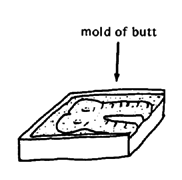
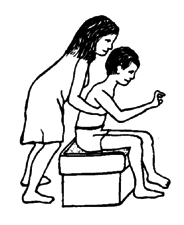
Before making a specially-fitted cushion, you can make a 'mold' of the person's butt by having him sit in a shallow container of soft clay, mud, or plaster. Note the bony hollows and form the seat to fit them.
Air cushions made from bicycle inner tubes are excellent for prevention of pressure sores, and for bathing on a hard surface. Use 1, 2 or more tubes, depending on size of tube and size of child.
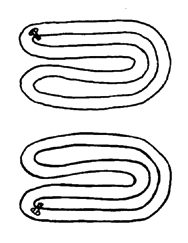

Bind loops of the tubes together with thin straps of inner tube.
Pump in enough air so that the whole butt is held up by air.
(idea from wheelchair rider-builders at Tahanan Walang Hagdanang (House With No Stairs), Quezon City, Philippines)
TREATMENT OF PRESSURE SORES
Watch for the first signs of a pressure sore by examining the whole body every day. Teach the child to do this using a mirror.

If early signs of a sore appear (redness, darkness, swelling, or open skin), change body positions and use padding to protect that area from pressure.

For larger areas (like the bones near the base of the spine), you can try using a small (motor scooter) inner tube to keep weight off the sore area. Put a towel over the tube to soak up sweat. (Sweaty skin against the rubber can also cause sores.)

WARNING: For small areas such as heels, never use a ring or 'donut' of cloth to keep weight off the sore. This can cut off blood supply to the skin inside the ring and make the sore worse. |
IF A PRESSURE SORE HAS ALREADY FORMED:

| Keep pressure off the sore area completely and continuously. | |
| Keep the area completely clean. Wash it gently with clean or boiled water twice a day. Do not use alcohol, iodine, merthiolate, or other strong antiseptics. | |
| Eat well. If lots of liquid comes out of the sore, a lot of protein and iron are lost with it. These must be replaced for quicker healing. Also take iron pills if signs of anemia are present. Eat foods rich in protein: beans, lentils, eggs, meat, fish, milk products. |
| Do not rub or massage areas where pressure sores might be forming. This could tear weakened flesh and make the sore inside bigger. |
IF A SORE IS DEEP AND HAS A LOT OF DEAD FLESH:
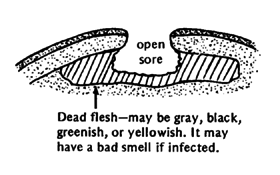
| Clean the sore 3 times a day. | |
| Each time, try to scrape and pick out more of the dead rotten flesh. Often, you will find the sore is much bigger inside than you first thought. It may go deep under the edges of the skin. Little by little remove the dead flesh until you come to healthy red flesh (or bone!). |

| Each time after cleaning out the dead flesh, wash the sore out well with soapy water. Use liquid surgical soap if possible. Then rinse with clean (boiled and cooled) water. |
If the sore is infected (pus; bad smell; swollen; red; hot area around the sore; or the person has fevers and chills):
| Clean out the sore 3 times a day as described. | |
| If possible, take the person to a 'clinical laboratory' where a sample from the sore can be removed and 'cultured' to find out what germs are causing the infection and what medicine is most likely to fight it well. | |
| If a 'culture' is not possible, try treating the person with penicillin, tetracycline, or (if possible) dicloxacillin. (See WTND, Page 351.) | |
| Follow the advice of an experienced health worker. |
If the sore does not get better, or keeps draining liquid or pus from a deep hole, the bone may be infected. In this case, special studies, treatment, and possible surgery may be needed. Try to take the person to a capable medical center. (See Chapter 19.)
Two folk treatments that help in curing pressure sores
PAPAYA (PAW PAW)
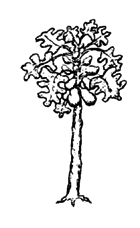
Papaya has chemicals (enzymes) that digest dead meat. Cooks use it to soften meat. The same chemicals can help soften the dead flesh in a pressure sore, and make it easier to remove.
First clean and wash out a pressure sore that has dead flesh in it. Then soak a sterile cloth or gauze with 'milk' from the trunk or green fruit of a papaya plant and pack this into the sore. Repeat cleaning and repacking 3 times a day.
HONEY AND SUGAR
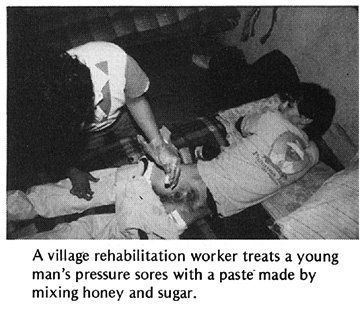
Once a pressure sore is free of dead flesh, filling it 2 to 3 times a day with honey or sugar helps prevent infection and speeds healing. This treatment, used by the ancient Egyptians, and recently rediscovered by modern doctors, works remarkably well. It is now being used in some American and British hospitals.
To make filling the sore easier, mix honey with ordinary sugar until it forms a thick paste. This can easily be pressed deep into the sore. Cover the sore with a thick gauze bandage.
| CAUTION: It is important to clean out and refill the sore at least 2 times a day. If the honey or sugar becomes too diluted with liquid from the sore, it will feed germs rather than kill them. |
Molasses can also be used. In Colombia, South America, doctors shave thin pieces off blocks of raw sugar and put these into the sore.

